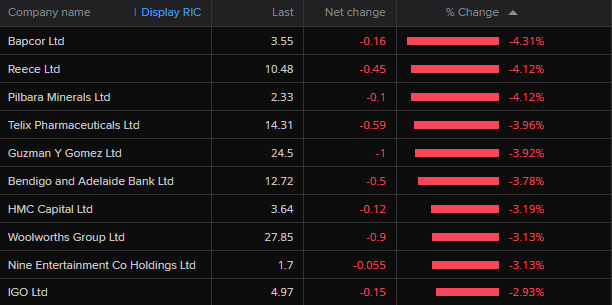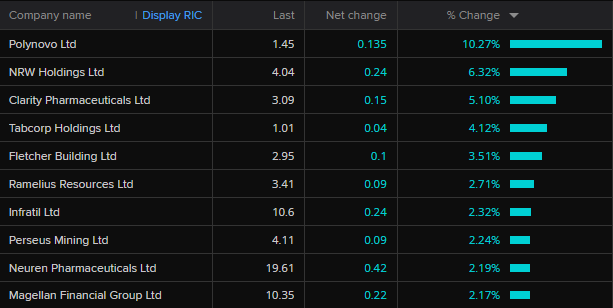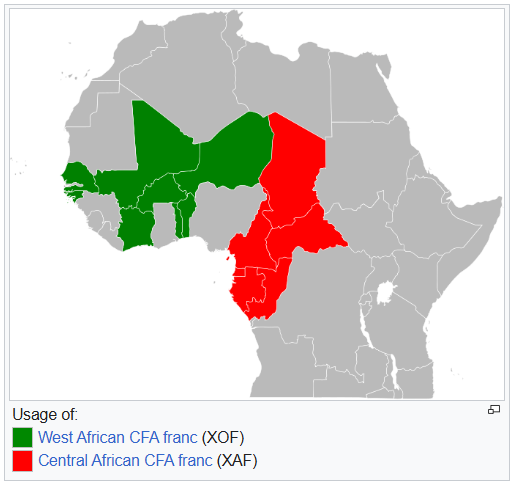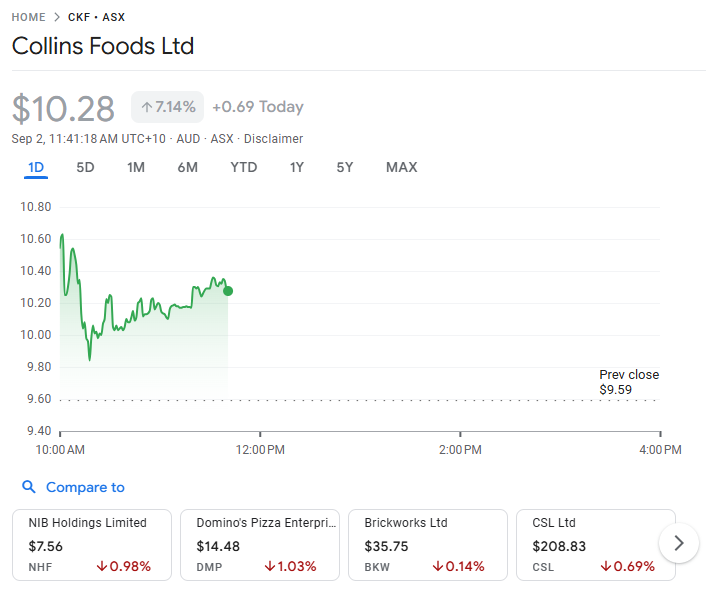Gold price hits record, ASX slips on retail sell-off — as it happened
Local stocks end lower as the retail sector gets hit and Woolworths and Wesfarmers trade ex-dividend.
Gold hit a record high above $US3,500 an ounce in Asian trade, as investors remain concerned about the safe haven status of US treasuries and the US dollar.
Follow the day's financial news and insights from our specialist business reporters on our live blog.
Disclaimer: this blog is not intended as investment advice.
Key Events
Live updates
Market snapshot
- ASX 200: -0.3% to 8,901 points
- Australian dollar: -0.2% to 65.40 US cents
- Nikkei 225: +0.3% to 42,310 points
- Hang Seng: -0.3% to 25,535 points
- Shanghai: -0.7% to 3,850 points
- Wall Street: closed
- FTSE: +0.1% to 9,196 points
- Eurostoxx: +0.2% to 551 points
- Spot gold: +0.3% to $US3,484/ounce
- Brent crude: +0.5% to $US68.50/barrel
- Iron ore: +0.8% to $US102.50/tonne
- Bitcoin: +1.4% to $US110,415
Prices current around 4:55pm AEST
Live updates on the major ASX indices:
Good night and good luck
Big day for Aussie economics nerds, with the National Accounts out tomorrow.
There's economic growth (GDP), data on profits, wages, household savings, and so much more to look forward to.
I can't wait!
LoadingAustralian shares close 0.3% lower
The benchmark ASX 200 index has finished down 0.3% at 8,901 points.
Discretionary and non-discretionary consumer stocks, real estate and healthcare led the decline, while the market heavyweight financial and mining sectors gained to stop the index posting a much heftier slide.
Just 60 companies out of the top 200 gained, while 133 fell.
Leading the declines were Bapcor, Reece and Pilbara Minerals.

Meanwhile, Polynovo, NRW Holdings and Clarity Pharmaceuticals toped the gains.

Chinese markets were generally lower, while the Nikkei edged up.
The Australian dollar was fairly stead around 65.39 US cents by 4:50pm AEST.
Queen Vic market redevelopment attracts controversy … over open-air carpark
I can understand the concerns about the affordability, or lack thereof, of the new apartments, or any effects on the old market buildings.
But to want to protect this:

From this:

That I don't quite get.
Is this a case of extreme NIMBYism or are there genuine problems with replacing a carpark taking up prime central Melbourne real estate with a public park?
Can any Melburnians please enlighten me?
Lock them into using a certain currency
Reading the ‘stablecoin’ article from Rabobank that Gareth referred to has one very telling statement in it. ‘The US could pressure Saudi Arabia , Kuwait and other like energy producing nations to insist on payment in US backed stablecoins so everyone will need to hold them.’The USA then controls energy supplies throughout most of the world if that happens ! Won’t be able to disagree with the nation that then decides if the lights stay on.
- Phillip
Bingo.
If there's a risk of the US dollar losing its power as the world's reserve currency, why not shift to stablecoin and force countries to trade in that, to maintain its power?
That's how the game is always played.
Think of how Harry Dexter White helped to cement the US dollar at the centre of the post-war Bretton Woods system, at the expense of Keynes's idea of using Bancor as a new supranational currency.
Or think of how the CFA Franc still ties 14 African countries to France's treasury, which restricts their sovereignty.
It's an old trick.

Gold hits record high above $US3,500, analyst believes it could run even further
Gold hit a record high of $US3,508.50 an ounce today, but has since edged back to $US3,493 (around 4:00pm AEST).
But Swissquote Bank senior analyst Ipek Ozkardeskaya believes the precious metal, along with silver, can trade higher still.
"In metals, gold hit a fresh all-time high above $US3,500 per ounce in Asia, surpassing its April peak," she notes.
"The rally reflects a softer [US] dollar but also strong central-bank and institutional demand as investors rotate out of US Treasuries.
"The share of US Treasuries held by foreign central banks has been declining for over a decade, but that shift into gold accelerated this year amid US debt concerns, ratings downgrades, trade tensions and geopolitical risks. Central banks' gold allocations even surpassed their US Treasury holdings this year.
"Meanwhile, Indian pension funds are seeking approval to invest in gold ETFs, hinting at strong demand despite record price.
"Silver also surged to its highest level since 2011. Both metals have further room to run. Yet, with the gold–silver ratio still above its long-term range of 60–80, silver may have greater upside potential."
Dark mode
Dark mode. Nice.
- Rob B
Hi Rob, our techies will be glad you noticed the new functionality, they were very proud of finally being able to get it done.
A follow up
Yeah it’s strange to think with all the technology changes you refer to , we might as well revert to the original decision maker and toss a coin ! 50/50 chance of being right is probably better than trying to decide if Trump Is right or wrong based on in depth analysis.
- Phillip
You're probably right.
There are so many complicating factors when trying to analyse what's happening over there, and one of them is that the rapid pace of change is causing so much chaos.
You can get a sense of what I mean when reading Rabobank's recent article on stablecoins.
This was the summary at the top of the paper:
- The post-WW2 and Cold War global architecture is crumbling; systemic geopolitical and geoeconomic instability is rising; so are risks of geo-financial instability as fiscal deficits grow, public debt rises, and hopes for rate cuts meet sticky inflation.
- Against this backdrop, stablecoins may play a pivotal role – though ironically they are likely to create further instability before cementing an alternative.
- This report will explain what stablecoins are; why people may want to use them; why the US government certainly wants us to use them; and the hypothetical geopolitical and market implications of their roll out.
Note that second dot-point:
"Against this backdrop, stablecoins may play a pivotal role – though ironically they are likely to create further instability before cementing an alternative."
So I guess if you can see a coherent strategy at play, and you know that that strategy will create more chaos and instability in the short-term, then you won't be surprised by the instability you're seeing.
However, the 'risky' part is extremely risky.
How is Trump achieving such rapid change? By declaring himself all powerful, by pouring thousands of ICE agents onto the streets to terrorise American citizens and non-citizens alike, by letting oligarchs have their way with peoples' personal data, and much more.
Those are the things Mr Picton didn't mention.
Westpac forecasts June quarter GDP of 0.4pc
Westpac's economics team has released its final forecast for tomorrow's June quarter GDP figure.
They've left their forecast unchanged at 0.4% quarter-on-quarter.
That means our updated listed looks like this:
- Citi: 0.5%
- ANZ: 0.4%
- CBA: 0.5%
- RBC: 0.5%
- Westpac: 0.4%
The dirigiste-in-chief
G’day Gareth. Always look forward to your weekend articles . Your review of Ben Picton’s comments last weekend had , for me , one really surprising element. He described current economic planning in the USA as “coherent - albeit risky.” Almost every other commentator describes Trump’s economic planning as “incoherent and incredibly risky “ Is there possibly a changing view amongst some analysts do you think?
- Phillip
Hi Phillip,
This is what Ben Picton had to say in one of his pieces:
Given that Trump is only six months into his second term and has already executed on most of the major planks of the MAGA economic program, it is clear that the economy is being re-made at an astonishing rate, and the commentariat is clearly struggling to keep up. Long term free market evangelists over at the Financial Times are now describing Trump as the ‘Dirigiste-in chief’, which of course he is.
So, without wanting to put words in Mr Picton's mouth, I took that to mean that he believes he can see a coherent shape to Trump's economic policies while many others still only see incoherence.
He also referenced this Financial Times article, which canvasses the views of a range of political insiders and businessmen in the US, some of which are quite supportive of Trump's tactics.
But it also had this view from Michael Strain, the director of economic policy studies at the American Enterprise Institute (one of the major 'free-market' think tanks in the US), which seems typical of those who only see incoherence:
“My read on it is it’s pretty unthoughtful, it’s pretty unstrategic.
“What we’re seeing is less strategic pivot towards state capitalism and more the president inappropriately shaking down private companies because he thinks that makes him a better dealmaker.”
The difficult thing about trying to analyse events today is how quickly everything is moving. The rate of change of technology is mindboggling.
We're having to read as many blogs and newsletters and books as possible, to try to keep up, but there are so cross-currents behind political and economic events that it's easy to get overwhelmed.
But Picton is telling his clients that he thinks there's a logic to what's happening over there - with US borders, with tariffs, with the government taking steps to secure power over the strategic semiconductor industry, to the government's very keen interest in stable coins.
So if he says he can see a logic to what's happening, whereas lots of other analysts can't, then he may have insights that others don't. But we can only be the judge of that after reading what he has to say.
CBA thinks June quarter GDP will be 0.5pc, RBC says 0.5pc
CBA's economics team has finalised its forecast for tomorrow's June quarter GDP figures.
It thinks the number will come in at 0.5%. It was previously thinking 0.4%, so it's revised its forecast upwards slightly.
RBC Capital Markets has also released its final forecasts.
It also thinks the number will come in at 0.5%. But it was previously thinking 0.7%, so it has revised its forecast down.
So there have been a few revisions coming through from different economics teams today.
And from what I've seen, we now have these forecasts for tomorrow's June quarter GDP:
- Cit: 0.5%
- ANZ: 0.4%
- CBA: 0.5%
- RBC: 0.5%
Readers love it
Nice work Molly🙌Unreal.
- Peter
ANZ economists think June quarter GDP will be 0.4pc
ANZ's economics team has finalised their GDP forecast at 0.4 per cent for the June quarter (with upside risk).
This follows weaker-than- expected data, including a small contribution from net exports (+0.1ppt), no addition to growth from public demand (+0.0ppt) and weaker business indicator results yesterday.
On top of the world
Congratulations to Molly Picklum.
She's been crowned world surfing champion after defeating American Caroline Marks at the World Surf League finals in Fiji.
It's the 22 year old's first world title (she's from Gosford, NSW).
Her world title puts the Australian flag back where it's supposed to be.

Market snapshot
- ASX 200: -0.17% to 8,912 points (live values below)
- Australian dollar: -0.2% to 65.38 US cents
- Nikkei 225: +0.2% to 42,278 points
- Wall Street: closed
- FTSE: +0.1% to 9,196 points
- Eurostoxx: +0.2% to 551 points
- Spot gold: +0.46% to $US3,492/ounce
- Brent crude: +0.44% to $US68.45/barrel
- Iron ore: +0.54% to $US102.25/tonne
- Bitcoin: +1.38% to $US110,371
Prices current around 1:46pm AEST
Live updates on the major ASX indices:
Citi says June quarter GDP growth will likely be 0.5pc
Ahead of tomorrow's June quarter GDP release, Citi economists Josh Williamson and Faraz Syed say they've revised their forecast down slightly.
They think Australia's economy will likely record growth of 0.5% in the June quarter, rather than 0.6% as they were previously forecasting.
They say that means GDP will print right where the RBA expected at 0.5% for Q2:
Assuming the ABS smooths private engineering construction rather than allowing the expenditure of a large gas production, storage and offloading terminal to be recorded in Q2, then GDP should increase by around 0.5% in the quarter.
This would be in-line with the RBA's implicit forecast and lift yearly GDP from 1.3% to 1.5%.
This would also be the highest pace since Q423 and add evidence to the slow u-shaped improvement in aggregate activity.
It also keeps our view of 1.8% growth by the end of the year intact.
Gold hits fresh record high of $3,508 per ounce
Tony Sycamore from IG says gold has hit a fresh record high of $3,508 per ounce, while silver has hit a high of $40.85 per ounce - its highest since September 2011 - as investors continue to flock towards the safety provided by hard assets and precious metals.
This week’s rally in gold and silver began mid-morning yesterday and coincided with a social media post by US President Trump who claimed that prices in the USA are “WAY DOWN” with virtually no inflation.
However, this narrative contrasts with recent economic data showing persistent inflationary pressures remain and comes as President Trump continues his dovish reshaping of the Fed Board as he pushes for sooner and deeper Fed interest rate cuts, into an economy which is growing at ~3.5% in Q3 according to the latest Atlanta Fed GDP Now reading.
The extent of any gains beyond $3500 for gold hinges on Friday’s non-farm payrolls report and next week’s BLS labour market revisions. If these are both soft, a move to $3750 is not out of the question as the scramble intensifies.
Where does 'GDP' come from?
Tomorrow, the ABS will publish its June quarter GDP figures.
The publication of regular GDP figures has become such a ritual in Australia that it's easy to forget that the GDP measurement didn't even exist before World War II.
A few years ago, I wrote a piece that explored the history of multiple attempts to measure national income, which eventually led to the GDP framework we're so familiar with.
An Australian statistician called Timothy Coghlan, who was the first government statistician for New South Wales (a post he held from 1886 to 1905), had tried to produce annual estimates of the national income of NSW in 1887.
The task Coghlan set himself was huge because he had to compile his figures without any income tax data (income tax wasn't introduced to NSW until 1897).
But his work wasn't sustained.
And by the time of the Great Depression in the 1930s, governments couldn't really say how bad the economic situation was because they still didn't have quality national statistics.
The Depression convinced US politicians that it was time to get serious about producing quality national statistics. And that eventually led to the creation of the GDP framework.
Would you like to be interviewed by the ABC?
Hello there.
I'll be covering the official GDP figures which are published tomorrow...
We'll see whether the economy has been growing.
But I want to talk to you about how things are going at a micro level - in your household.
Are you spending less as the cost of living bites? Or perhaps you've had a pay rise and find you're spending a bit more these days? How are you feeling about the future?
Please send me an email on stewart.emily@abc.net.au and you could appear on The Business program.
Collins Foods up 7.14pc
Collins Foods shares are up 7.14% (+69cents) to $10.28, after it gave a trading update to the stockmarket this morning.
It said for the first 18 weeks of FY26 (28 April 2025 - 31 August 2025), total company sales were up 6.7% on the prior corresponding period.
Its share price had gained as high as 12.5% earlier this morning, touching $10.79 a share, which was the highest since 1 March 2024.

It has business in Australia, the Netherlands and Germany, and the sales growth in its German division has done particularly well.



